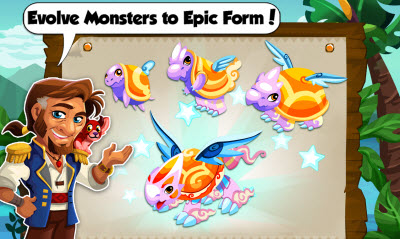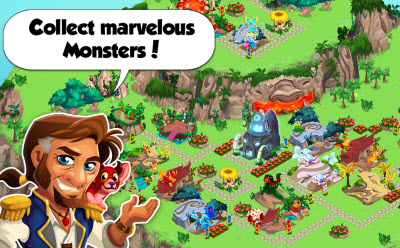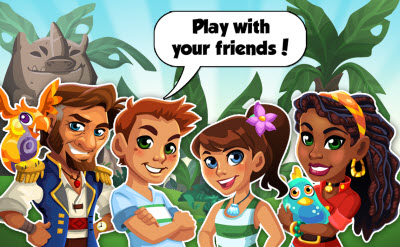GamesBeat: I know there was a time a while ago when your games were taken down by Apple. Is there some lesson you drew out of that experience, as far as how you need to have a strong relationship with the platform owner?
 Tam: That was the really early days, going back to 2009. Over the years, as the platform’s evolved, a lot of policies have solidified, and policies have changed over time. From that experience, we learned that the platform, specifically Apple, is actually very fair. When they see a problem, they let people know. As soon as it comes up you’re on the phone with them. You let them know, okay, here’s the problem, we can fix it together, and we do it. That’s why our games went back to the App Store right after the problem was resolved. I think a lot of platforms nowadays take an approach where, basically, their job is to maintain the integrity of the ecosystem. Storm8 is certainly aligned with that goal, because that’s the best for everyone.
Tam: That was the really early days, going back to 2009. Over the years, as the platform’s evolved, a lot of policies have solidified, and policies have changed over time. From that experience, we learned that the platform, specifically Apple, is actually very fair. When they see a problem, they let people know. As soon as it comes up you’re on the phone with them. You let them know, okay, here’s the problem, we can fix it together, and we do it. That’s why our games went back to the App Store right after the problem was resolved. I think a lot of platforms nowadays take an approach where, basically, their job is to maintain the integrity of the ecosystem. Storm8 is certainly aligned with that goal, because that’s the best for everyone.
GamesBeat: It’s interesting that your background… A lot of the startups that have moved into the online, social, and mobile space have a lot of game industry veterans. Sometimes the whole team is coming from the triple-A console game market. You guys are a contrast to that, at least as far as how you started. How do you feel about the talent that can make mobile games?
Tam: The team at Storm8 is a very talented one. We’re well-positioned for making mobile games. Let me give you an example. When I came from Facebook to mobile, the first thing I noticed is that mobile is totally different from the Facebook environment. First off, you have this multiplatform approach. On Facebook, everyone was very focused on the one platform. On mobile, you have to be aware of all the different platforms at the same time. We invested a lot into the technology, so that we were able to take advantage of that. A great example of that is the newest game that we launched, Monster Story. It launched a week, two weeks ago? This is the first game we released the same day on both iOS and Android. The way we make that happen is we invest heavily in the technology, so we can take advantage of the different platforms. We’ve had that mentality since day one.
We’ve built this engine, called the Dolphin engine, that allows us to take advantage of the different platforms and maximize the user experience here. It’s different from other people’s cross-platform engines. Oftentimes, when people say they have a cross-platform engine, what they mean is that they only write the game once and then they can port to different platforms. We don’t agree with that, and here’s the reason. Each platform has its unique offerings that can totally enhance the user experience for that platform. We don’t want to limit ourselves by not tapping into that. Our approach is different here. We said, for each platform, we’re going to build natively for each one, so we can take advantage of them. But we don’t want to compromise on the development cycle. We don’t want to compromise on the time to market. What we do is, we made the engine such that it can accelerate each development process by 100 percent. For someone who wants to build on this engine, it’s only going to take you half as long to do it for iOS and half as long to do it for Android. In combination, we’re actually on par or even gaining time when we want to launch on multiple platforms, compared to our competitors. That’s how we achieve that. I think it’s a perfect solution, because it allows us to tap… For example, the user interface. Android and iOS have slightly different offerings for the user interface, and we want to make sure that the user who comes to the game feels it fits very seamlessly with their platform. We’ve built this engine so we can do that on both platforms in the same amount of development time.
GamesBeat: It sounds like HTML 5 as a universal solution isn’t going to work for you guys. Or something that’s a hybrid of HTML 5. It’s been proposed as a universal format for games on mobile devices or Facebook, but it sounds like, from what you just said, that that’s probably not an approach you’re going to take.
Tam: No, you’re right. Right now we do native development for iOS and native development for Android. We’ve experimented with HTML 5. We actually worked on it with Facebook initially… If we want to do HTML 5 we’ll do it natively. We’ll take advantage of all the good things that are unique to HTML 5. Our engine actually allows us to do that. We’ve done that with some of our games… I think it was in 2011 we did that. If we want to go into HTML 5 our technology totally allows that, and it will be unique and native to HTML 5.
 GamesBeat: You may have missed one part of the question about whether you like to hire seasoned game developers from the core, triple-A industry… Do you like to do that?
GamesBeat: You may have missed one part of the question about whether you like to hire seasoned game developers from the core, triple-A industry… Do you like to do that?
Tam: Sure. When we hire people, we have a very strong focus on hiring the best talent, and the best talent for us will be someone who can learn. One thing we’ve learned so far in the mobile space is that it moves so fast. It changes very quickly. The only way to stay on top is knowing that the most important knowledge that comes with you is your ability to learn. My answer to your earlier question is yes, we will hire and we have hired people who come from triple-A experience, with the thinking that they have the capability to learn. That’s what we care about. It’s not really about whether you have 10 years of experience in social games, because nobody has 10 years of experience in social games. What matters is whether they can learn.
GamesBeat: I can see the circumstances under which your kind of company is one of the best to have. The mobile game industry changes quickly, and if you have to have small teams that move fast and get a game out in a very short period of time, then that is ideal. I don’t know what your average is and how big your team sizes are. Actually, what are those?
Tam: Right now, in total, the whole company has 150 people. Right now we’re averaging one game a month. I’d say the dev cycle for us is between two and three months, from conception to shipping the game. The one thing you need in mobile social games is… Our job doesn’t stop after launch. Our job just gets started. We’re constantly using metrics to tune the game. We constantly push out more content. We keep adding new features after launch. That’s why we’re able to have a dev cycle of a two to three months to launch a game, and then constantly tune it and make it better. The team size for making a game in that amount of time is actually very small. Usually it’s less than 10 people. I’d say it hovers around six to eight.
GamesBeat: That’s the way it was in the early days of the console games. The question is, what happens if the market moves toward the direction that the triple-A games moved, where they have 50 or 100 people doing very high-end 3D graphics? If the market wants games like Infinity Blade, and will accept nothing less than that, what happens then for your kind of company? How do you compete?
Tam: That’s a really good question. I like to separate out the high quality and the timeliness. Back in the day, 2009, when we first started with less than 10 people, we were launching one game a month. We certainly gained some traction there. Today, we have 150 people and we’re still launching one game a month. We have more people, but we’re not launching faster. Our quality has stepped up tremendously. At least 10, 15 times, if you just do the simple math of 10 people doing one game then and 150 people doing one game now. I think that’s the right way to go. You’ll see mobile gaming, as it matures… The production values are going to keep pushing up, and that’s what we’re about to do. That’s definitely happening. Two things that makes us so unique and different, though… The first thing is, we have this network that I talk about. What it allows us to do is, we save money on the marketing front, because we don’t have to put that much into marketing. That means we can hire more talented people. We can put all that money we saved on marketing into production values and innovating with mobile gaming. That’s what’s happening. Second, we push on the technology. The Dolphin engine that I talk about is one of many things we’ve built here that will allow us to constantly push the production values up at a fairly decent cost, and also at a fairly rapid pace. Part of it is the graphics engine. It’s totally proprietary, but you can compare it to the Cocos2d engine out there. We built a graphics engine and a game development engine to help us keep getting better and better graphics. If you look at the latest game we have, Monster Story, the quality in there is just day and night compared to the games we launched two years ago, or even a year ago. The number of animations, the frame rate, all that stuff is advancing.
 GamesBeat: I guess the good thing is that the market is getting bigger all the time. A lot more devices are being sold every day.
GamesBeat: I guess the good thing is that the market is getting bigger all the time. A lot more devices are being sold every day.
Tam: Definitely. We estimate at least 1.7 million new devices are activated every day. That’s why we keep pushing on getting our games to the market as soon as possible. Every day we don’t push the game out, we lose 1.7 million potential customers. That’s absolutely true.
GamesBeat: How do you feel about Windows 8?
Tam: We’ve taken a look into it. Right now we’re not developing for it, but I think it has a lot to offer to the mobile ecosystem.
GamesBeat: And what about expanding more into different territories? Japan or China or wherever else?
Tam: It’s definitely on our minds. For the longest time, we’ve been dominating in the U.S. and the western world. English-speaking countries. We certainly understand that the Asian world and other countries have a higher growth rate than some more developed countries. We’re currently working on it.
GamesBeat: Where do you see Storm8 in, maybe, a year or two from now?
Tam: We’re definitely expanding. We’re not just expanding on one vertical. We’re actually expanding on at least three different verticals. One is genres. We’re expanding with Bubble Mania… This company’s DNA is always reinventing itself. We’re constantly stepping into new genres, from RPGs to casual to core to arcade… The second vertical is more platforms. We started with iOS, then we moved to Android, we’re moving to Amazon, we’re on Facebook as well. Another platform is another audience. We’ve built the network from zero to six million plus in three years, and I think there’s still a lot for us to do.
GamesBeat: How do you feel about the state of the whole game industry right now? There’s a lot of attention focused on some big problems, like Zynga’s stock price and OnLive’s collapse…
Tam: I’ve certainly seen a lot of news stories about those. I think everyone can see that mobile is the new frontier for gaming. A lot of companies talk about how they’re expanding to mobile… Right now, at Storm8 we’re seeing a lot of growth. We’re not slowing down. We’re hiring even faster than we used to be, and our user base is growing very rapidly. The story here is, anyone who doesn’t get mobile right is going to suffer. A lot of companies are trying their best to gain traction on mobile. We’re in a unique position where our focus was on mobile since day one. We have the first hard part out of the way. We have that traction already. We can keep moving, keep innovating. I think the future’s very bright for Storm8.
VentureBeat's mission is to be a digital town square for technical decision-makers to gain knowledge about transformative enterprise technology and transact. Learn More
